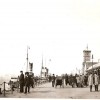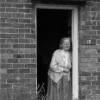The '60s slum clearance - my experience by Freddie Forrest Before I insert my story, I would like to mention that I worked with Terence (then known as "Terry") in Hunter's Foods in Broadgreen in 1969 but never knew of his film ambitions. I travelled with him regularly on the 6 or 40 bus towards town after work. It was only when I noticed the Braddocks flats in his Trilogy and realised that I knew a Terry Davies who lived there that I clicked it was the same person. Another connection is that the street in my story is Phythian St., which was next to Kensington St.,in which Terence lived until moving to the Braddocks flats. I should be grateful if you would pass my E-mail address on to him in case he would like to get in touch. Thank you. The story that follows is an extract from a book I am writing about being brought up in Liverpool in the '50s and '60s:- " Our house was obviously one for which demolition was the only option because of its structural and dampness problems. My memory of the phrase �disrepair order� being used by my parents suggest that the landlord, Noon and Ellsworth, was reluctant to carry out repairs unless compelled to by law. Compensation to the landlord following granting of a CPO would not be much more than land value so no doubt repairs all but ceased on our house in the early 1960s, although we lived in it until mid-1968. It was probably in early 1963, just after I started at the Liverpool Collegiate School, that I came to realise that wholesale slum clearance was in the offing in our area and that neighbours and friends began to be decanted apparently randomly to other parts of Liverpool. Although it was over five years later when we finally moved out, I do not think that we were the most reluctant family in our area and do not recall that we received a plethora of re-housing offers. Up to my sister�s tenth birthday in the summer of 1966, indeed, we would have qualified for a house with a garden, which, no doubt, we would have accepted. I recall receiving only two offers prior to the one we accepted; these were a flat in a new, high-rise block off Netherfield Road and a ground floor maisonette (but strangely without a rear exit into an open area!) in Round Hey, Cantril Farm, both probably in 1967. These properties, incidentally, are long since demolished and no doubt long before the council had paid for them. That the process dragged on for so many years was because its scale meant that many new properties had to be built, some on cleared areas, before slum dwellers could be re-housed. Destruction is much easier than construction but a few reluctant families could seriously delay the former. It also seems that government grants to local authorities for demolition were often not synchronised with those for construction. The logjam caused by all this meant that, a few years into the programme, some temporary prefabricated dwellings had to be built into which families could be temporarily decanted from their slums until a more permanent solution could be built on fully cleared sites. These temporary dwellings were reminiscent of the �prefabs� built on many sites throughout Liverpool immediately after World War II, many of which, including those in Sheil Park, lasted until the start of the 1960s slum clearance programme. Some of the new prefabs were built close to us, off Gloucester Place and also between Prescot and Erskine Streets, facing today�s Royal Hospital. Thankfully, these did not last as long as their predecessors. To a boy in his early teens, the empty properties left by the slum clearance were an adventure playground. They were, of course, �tinned up� immediately after being vacated but this was never an obstacle for long. Resourceful adults benefited from the empty properties by removing copper electricity cable and lead gas and water pipes and selling it to local scrap yards, an activity in which we also participated as we were fortunate to have Packenham�s scrap and rag yard at the top of Phythian St. The people working there knew us and so took our metal but were always careful when weighing it in to check that we had not put some heavy, less valuable lead in the copper bag! I like to think that this was a recycling exercise rather than theft as, from what we witnessed, the demolition contractors made no great effort to recycle. They just seemed intent on flattening the site with their metal ball and clearing it as quickly as possible. How many square miles of sound Welsh slate found its way on the back of a lorry to a hole in the ground somewhere? But this was long before our age of home ownership, D.I.Y. and recycling so what workingman would want to improve his rundown, rented property? Going regularly into these empty properties made us appreciate just how structurally delicate some of them were. The police usually made at least a token effort to chase us out of them and, fearing a cuff across the ear, we fled and I can recall a few close calls experienced by my friends. In one, a friend, jumping from a back bedroom window was followed to the ground by the substantial stone windowsill from which he had jumped and which narrowly missed him. In another, a friend, being third or fourth to jump from a back bedroom window on to an apparently sound Yorkshire stone outside toilet roof went straight through it but luckily the roof reached the toilet floor before he did! Apart from scrap metal, those moving out often left unwanted old furniture and other household items, which the scavenging adults and children often took for their own use. I built a small, low rise lean-to shed in our backyard with materials recycled from the empty houses to house my pet rabbits and mice and I still have a 1930s dictionary salvaged, probably in 1965, from an empty house in Baker St. Teenagers also made regular use of the empty houses for what could be termed early romantic manoeuvres! They were ideal for this throughout the year, keeping you away from prying adult eyes and also out of the rain, snow and cold during the winter. The darkness did not seem to matter! The empty, derelict houses also allowed us to indulge in acts of wanton vandalism such as breaking windows and even knocking down walls at no financial cost to anybody, although I suppose elderly people in adjacent houses must have been worried at the noise. The houses vacated early in the programme waited years before our unofficial recycling and demolition activity was followed by the demolition contractor. His visits gradually opened up new vistas to adjacent streets and eventually to Kensington and West Derby Road beyond. Those most reluctant to move might eventually finish up in the only inhabited property on one side of a street or on a long stretch and the demolition contractor would clear what he could, sometimes leaving standing just your house and the empty ones immediately adjacent as support for it. This piecemeal exercise would have achieved two purposes, one intentional and one (perhaps?) incidental; firstly, a gradual clearance of the site needed for new build and, secondly, a weakening of the willpower to stay of those holding out for a specific location or type of property. Even without the gradual demolition, the slow depopulation of an area made it a less welcoming and more frightening place, especially to old people at night. The dereliction might even have brought back memories of the war years to some and the emptying of an area also meant that the remaining inhabited houses were more prone to being burgled, which happened to us several times. One possible burglar entered our house through the back door in daylight and, upon seeing several people there, apologised for his mistake saying he thought the house was uninhabited! Living conditions in a partially cleared area were definitely more arduous than those prior to slum clearance. Our turn to move finally came in early June 1968, five years after friends and neighbours began to move and the day before my first written GCE A level exam (a fact commented upon elsewhere). Our destination was a brand new 3-bedroom ground floor maisonette, with front garden but shared yard, in Stonedale Crescent, off Stonebridge Lane, in Croxteth." Enter your story Back to main stories page |

 Latest Pictures (view more) Latest Audio (view more) Concrete Oceans by John Reilly |
Useful resources
- Non Gamstop Casinos
- Casinos Not On Gamstop
- Siti Casino Online Non Aams
- Casino Non Aams
- Best Online Casinos
- Casino Sites Not On Gamstop
- Non Gamstop Casinos UK
- Non Gamstop Casino Sites UK
- UK Casino Not On Gamstop
- Online Casino
- Non Gamstop Casinos
- Non Gamstop Casinos UK
- Non Gamstop Casinos
- Casino Not On Gamstop
- Sites Not On Gamstop
- Casino En Ligne
- Sites Not On Gamstop
- Best Slot Sites
- Slots Not On Gamstop
- Best Non Gamstop Casino




